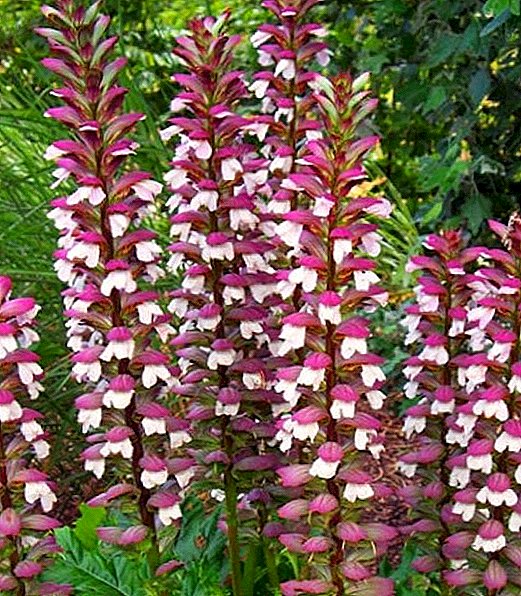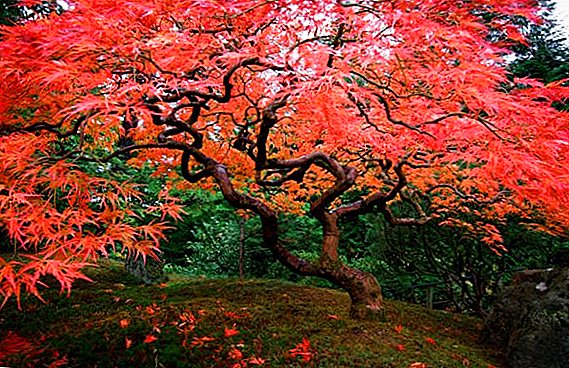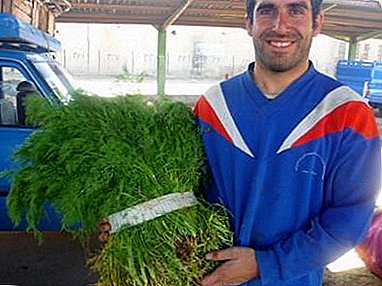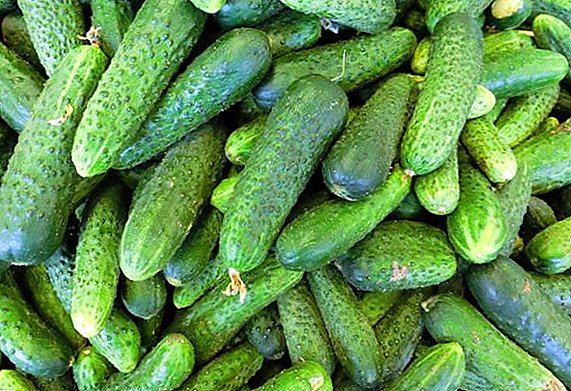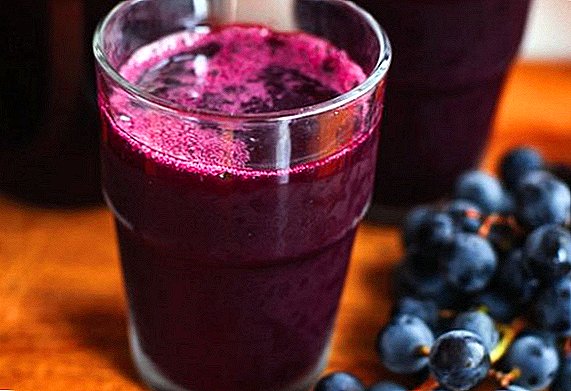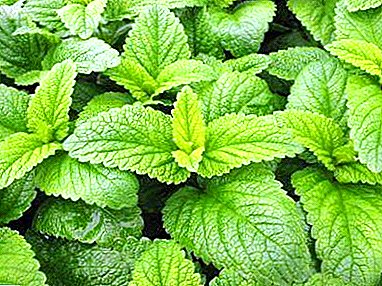 Anise is an annual plant belonging to the umbrella family (celery). Externally, it differs from its "relatives" in the family and has interesting properties that are discussed in the article below.
Anise is an annual plant belonging to the umbrella family (celery). Externally, it differs from its "relatives" in the family and has interesting properties that are discussed in the article below.
Plant description
This one-year bush can be grown to a height of 30-60 cm with a strong straight stalk. The leaves are green, shiny, pointed to the end. Flowering occurs in the first half of summer, the flowers are collected in inflorescences of 7-15 ray umbrellas, like most plants of this family.
Did you know? In Russia, anise appeared in the 17th century and almost immediately took root in the south-eastern and southern provinces, from where it was successfully exported to Europe.
When grown from seed, the plant ripens in August. The seed pods look like an ovoid or heart-shaped two-pod capacity, where there are fruits that smell of spices, taste like nutmeg and look like caraway or dill fruits.
Sometimes culture is confused with a badian, considering it its second name. However, this is a mistake - anise anise, or star anise is a completely different plant, though similar to anise.

Chemical composition
Different parts of the culture contain many components that make it a mine of useful substances.
Trace elements (per 100 g) mg:
- iron - 37;
- zinc - 5.3;
- copper - 0.9;
- selenium - 0.005.
- potassium - 1440;
- Calcium - 645;
- phosphorus - 440;
- magnesium - 170;
- sodium - 16.
- C - 21;
- PP - 3;
- B3 (pantothenic) - 0.8;
- B6 (pyridoxine) - 0.65;
- B1 (thiamine) - 0.34;
- B2 (riboflavin) - 0.29;
- A - 0.016;
- B9 (folic acid) - 0.010.
- carbohydrates - 35.4;
- proteins - 17.6;
- fats - 15.9;
- dietary fiber - 14.6;
- water - 9.54;
- ash - 6.95;
- saturated fatty acids - 0.01.
Important! Anise seeds remain viable for three years from the time of collection.
Useful properties of anise for the human body
The plant benefits the person in various forms and types:
- Antioxidant properties of the essential oil, which is a part of the flower, are used to remove free radicals from DNA cells, which allows to fight against malignant tumors.
- Antibacterial components allow you to include anise ether in the composition of toothpastes.
- The anti-inflammatory effect is comparable to that of aspirin.
- Preventive property against anemia.
- Mixed with sassafras oil, it is an insecticide for domestic insects.
- Bait for fish fishing.
- Culinary seasoning.

Babies, allergy sufferers and pregnant women should not be given anise preparations, as they can cause allergies, individual rejection, adversely affect the health of the fetus and even cause premature birth.
Features of anise
The fruits and parts of the plant are used in various spheres of human life. Some culinary dishes get an additional flavor, the cosmetic industry uses the useful qualities of the culture, and traditional medicine uses healing properties.
In cosmetology
Not so long ago, cosmetologists discovered the quality of anise, relaxing skin. Since then, plant seed oil has been used as a cream for mature skin with a smoothing effect. Anise oil is added to face masks and creams and body lotions. In this case, a small amount is enough - 2-3 drops per serving of a mask or a bottle of lotion.
Did you know? In Europe, the plant appeared in the XIV century. Its first use in the Old World was not at all culinary, - anise, because of its high cost, was a means of payment.
In folk medicine
Traditional medicine uses the plant for various diseases:
- chronic and acute throat diseases - decoction gargle;
- bleeding gums - holding the decoction in the mouth;
- skin burns - an ointment from a mixture of anise oil and egg white;
- eye diseases - washing with cooled infusion;
- renal diseases - warm infusions and decoctions;
- reduced secretion of milk - tea from the leaves and seeds.
In cooking
In various cuisines, the plant is used in the form of fresh or dried greens, as well as whole or ground fruits. Fresh greens are added to salads and fish dishes, and dried umbrellas and stems, like ordinary dill, are a spice for pickles and preservation.

The culture is used for dough when baking - from pies to baking, where both greens and ground seeds are added. Also, the fruit is put in sweet soups, puddings, cereals. Saute, stew, roast or any vegetable mix can also be varied with this spice.
Rules for the collection and storage of anise
For use in salads or drying for the winter, greens grown in open ground, harvested before flowering. During this period, she had already gained taste and juiciness, but had not yet begun to waste energy on the formation of umbrellas. Drying is carried out in a cool and ventilated room, where bunches of greenery are hung from the ceiling.
Important! In the case of drying the grass in bulk, you need to mix it thoroughly for better drying and to avoid the appearance of mold.
Seeds for food use are harvested after yellowing of the stems. Bundles of cut plants are tied up and suspended for final drying under the ceiling in a shed or other ventilated utility room. After that, the umbrellas are threshed, and the obtained seeds are stored in a sealed package, - to better preserve the flavor.
Fruits for medicinal purposes are harvested differently - in early autumn, in dry weather. Seeds are dried in a special dryer or a conventional oven at a temperature of about + 50 ° C and packaged in zip-bags or sealed containers. In such conditions, in a dark dry place, they can maintain their properties for three years.

Possible contraindications
With all the beneficial and taste properties of anise, it has some contraindications that can seriously harm human health. As already mentioned, this spice is contraindicated during pregnancy.
In addition, it is not necessary to use the plant in food or for treatment in cases where there are:
- chronic diseases of the gastrointestinal tract;
- ulcers;
- skin ailments, rashes, acne, acne;
- allergic reactions.
Find out the difference between star anise and anise.
Long-term use of drugs from this culture can cause a cumulative effect. To avoid this, it is necessary to alternate weekly cycles of reception and rest from the plant or its products.
Anise has an excellent smell, is an exquisite spice on the kitchen table and a good drug. It is used not only in traditional medicine, but official medicine also uses it as an ingredient in certain medicines. This unique plant will not only decorate the garden, but also help in the fight against ailments.



